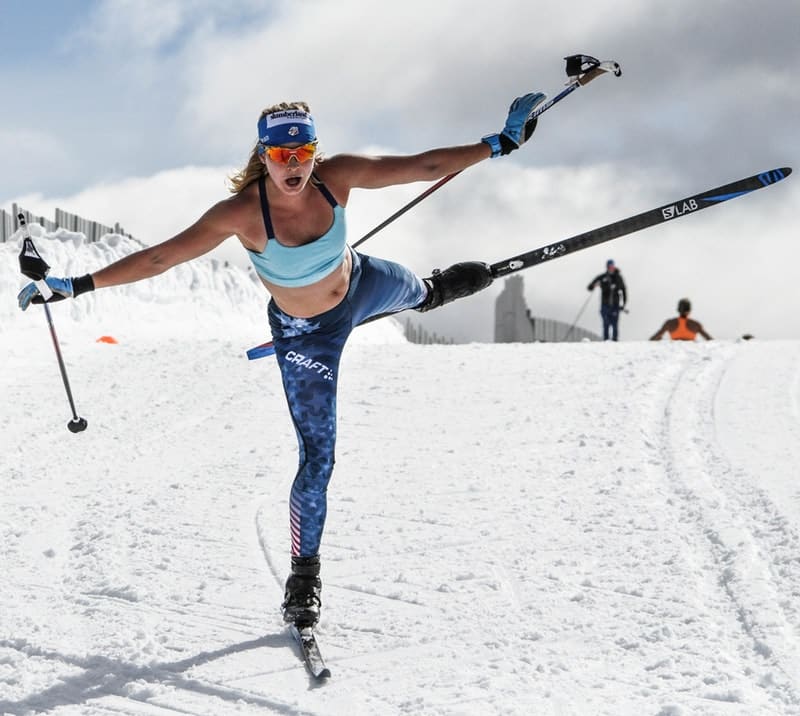It’s last February, the FIS Nordic World Ski Championships in Lahti, Finland, before the women’s freestyle sprint final, a 1.6 kilometer dash. The television camera pauses on each skier at the starting line for an introduction. The women nod, maybe smile, give a perfunctory wave.
Then the camera finds Minnesota native Jessie Diggins.
She waves both hands, shakes her fists above her shoulders, punches the air, her face split in a smile so wide it shows more enamel than a bathtub. She shimmies her skis with a hip wiggle and all but bursts from her ski suit.
“You love her enthusiasm as well as the way she skis,” the commentator says.
An instant later, poised for the gun, she’s completely still, skis steady, poles planted, hands in front of her shoulders, head tipped down. Pure focus.
The gun fires; she explodes across the snow.
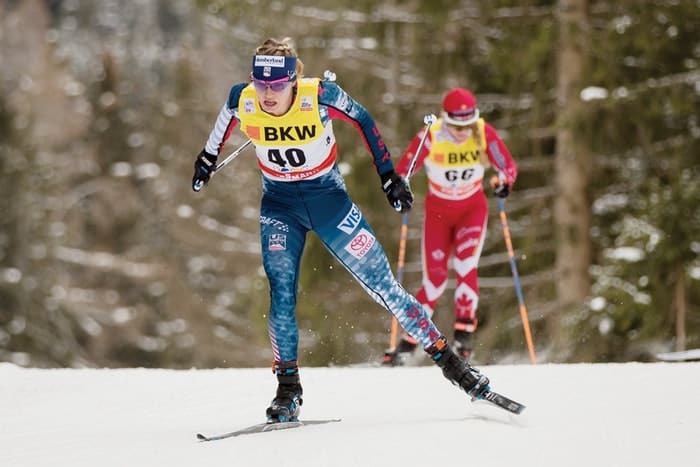
Three minutes later, she has secured silver. Her second medal of the week.
This is Jessie Diggins. She is, in a word, ebullient. And, in another, fierce.
Yin and yang. On her way to make history in PyeongChang.
“It’s something that’s never been done before by American women,” Diggins says. “That’s win an Olympic medal. It really motivates me.”
She’s talking to a group of more than a hundred high school skiers from across the metro area and adults in the upper room at the Theodore Wirth Chalet in Minneapolis. On this Wednesday evening in November, she has led them in a workout, then changed from her blue-and-white U.S. Ski Team warmup into jeans and a maroon short-sleeved jersey with an orange S on the front (not quite Superwoman, though close—it’s the Salomon logo). Her blond hair swirls past her shoulders.
She flicks through slides on a screen beside her. There she is doing a pull-up in a gym, her face grimacing. A shot of her with teammates on skis in the mountains. In Hawaii on her month off (April) with a childhood friend. They went bungee jumping. Hiked a forbidden staircase up a mountain. Surfed. Snorkeled. “I came into the season mentally rested, ready to go.”
Next a slide listing her goals. “In May I wrote a training plan with my coach, Jason Cork, so that every workout has a purpose,” she says. “The process of trying to become faster, it’s fun. Like a game. What can I do today to get faster?”
Her voice is raspy, shades of Debra Winger. With each slide, it rises, her enthusiasm accelerating. You can almost hear emojis in it.
Diggins joined the national team at 19, after graduating from Stillwater High School, and with four World Championship medals is the most successful American cross-country skier, male or female.
After her prepared remarks, Diggins takes questions from the audience. She sleeps 10 to 11 hours a night. She has 45 pairs of skis. She loves to dance. Her favorite song at the moment is by Portugal. The Man: “Feel It Still.” And she loves chocolate more than skiing: “If you told me I couldn’t eat chocolate for 10 years while racing, I’d quit.” They laugh. “No, really. I would.”
You could say that Diggins’ road to South Korea started in Canada. Her mom, Deb, was born in Montreal, raised in Duluth; her father, Clay, is from Thunder Bay. But it’s truer to say the road started in St. Peter. That’s where Clay, a hockey player converted to endurance sports, wooed Deb on skis while they were undergraduates at Gustavus Adolphus College.
They married and settled in Afton, Minnesota. When baby Jessie came along, Clay loaded her in a backpack, and the couple kept on skiing. She loved it. Some of her earliest memories are of tugging on her dad’s hair and yelling, “Mush!” “I wanted to go super-speed,” she says.
They enrolled her in the Minnesota Youth Ski League when she was four years old, though she was in it more for the hot chocolate afterward. She took violin lessons, played soccer, swam, climbed, and danced. She wanted to be a ballerina. Or a firefighter. An astronaut. It wasn’t until seventh grade that she truly became a skier.
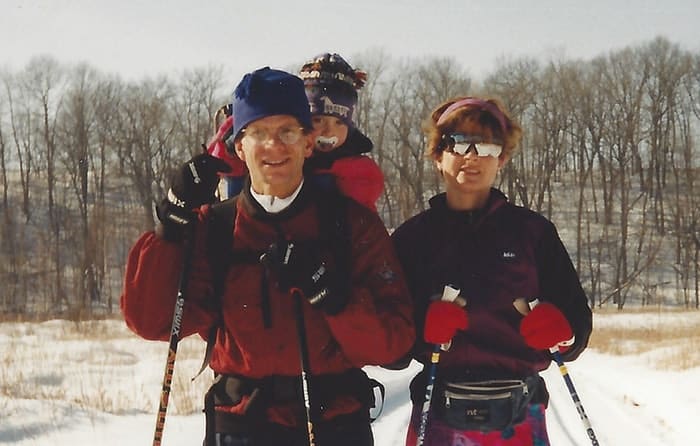
She skied junior varsity that winter for Stillwater High School, one of the state’s perennial Nordic skiing powerhouses, until the conference championship. Twenty minutes before the 5K freestyle race, Jessie was hanging out in the chalet, eating gummy bears with her middle school friends, when the coach told her one of the varsity skiers got sick and Diggins needed to race.
Even though this would be her first varsity race, and the 13-year-old would be competing against girls five years her senior, she yanked on her skisuit, did a quick warmup, and won the race.
“I remember thinking that racing could be super fun and that I wanted to start training seriously so I could see how far I could take the sport,” she says.
The following season, Ahvo Taipale, who coached the University of Minnesota women’s Nordic team to two national titles, watched Diggins win a conference race and prophesied that she would become a champion. “She’s got the fire in the eyes,” he told her parents.
He was right. In 2007, Diggins won the state championship as a ninth grader, and repeated as a sophomore. By then, she was beating the boys on her team, which pissed them off. Once they realized Diggins wasn’t just any girl—that she was a contender in international world competitions—they vied to see who could finish closest behind her.
Diggins missed the chance to three-peat as a state champion because she was in France for the FIS Nordic Junior World Ski Championships. That year, Annie Hart, a junior at St. Paul Academy, won the state championship. Next year, Hart and Diggins, both seniors, competed at Junior Worlds in Germany, and became friends. They returned in time to contest the state title.
A reporter suggested that the friends finish together, hand in hand, which insulted Diggins. “You want to be nice and to win,” she tells the high school kids inside the Wirth Chalet. “You don’t have to be not competitive if you’re a friendly person.”
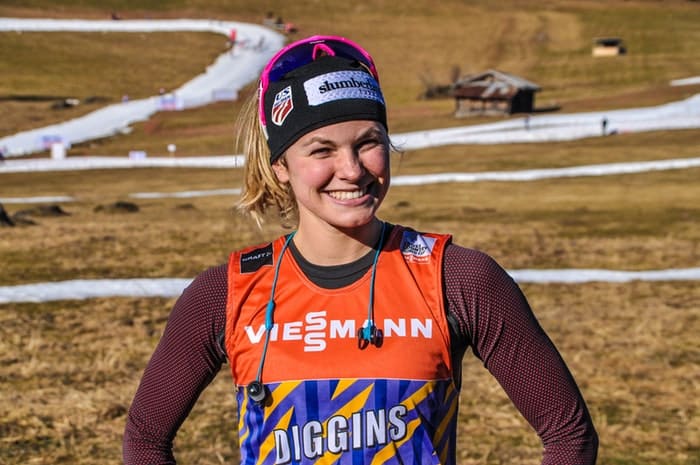
The state championship title takes the combined time from two events: a 5K freestyle or skate race where the motion resembles ice skating, and a 5K classic, where skiers move their legs and arms back and forth like they’re running. Diggins, strongest in the skate portion, took a 15-second lead going into the classic event, where Hart excelled. Hart caught Diggins, who had started 15 seconds earlier, with a kilometer left, then pulled ahead. They came around a bend into the final straightaway with Hart leading by about 10 meters.
In the video of those last 150 or so meters posted on YouTube, you can hear someone say, “Annie’s got it.”
The two state champions are double-poling—skis straight, hands reaching, planting their poles and propelling themselves forward with core crunches. Diggins shifts from directly behind Hart to a track on her left, keeps pumping furiously, and the gap narrows.
“Jessie’s coming,” Hart’s mom says.
Both girls are digging, pumping, straining. Nearing the finish line.
Now they’re side by side. “Dang it, Jessie.”
Diggins powers past to win by a ski length.
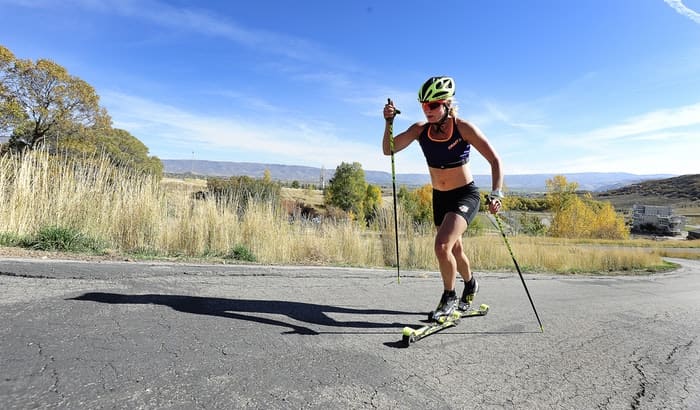
What you don’t see on the video is that Diggins had mononucleosis, not yet diagnosed but making its presence known with an exhaustion that besieged her body. A month earlier, she had beaten Hart on this same course by nine seconds. This race would never have been so close if Diggins had been healthy.
But the video’s not over. As soon as she’s crossed the line, arms raised, Diggins turns and embraces Hart.
“Where Jessie stands out is she does it fiercely on the course and graciously off,” her father says.
Diggins and Hart remain friends. They lived together last summer in Diggins’ condo in Stratton, Vermont, where they train together on the Stratton Mountain School Elite Team. It’s not uncommon for Hart to wake up to find a muffin waiting for her from a batch Diggins has baked the night before beside a note saying, “Good morning.”
Jessie Diggins: She’ll beat you, then bake you muffins.
The plan was to take a gap year between high school and Northern Michigan University, where Diggins had been granted an academic scholarship and a spot on one of the nation’s top collegiate Nordic teams. First, she wanted to test herself among the world’s best.
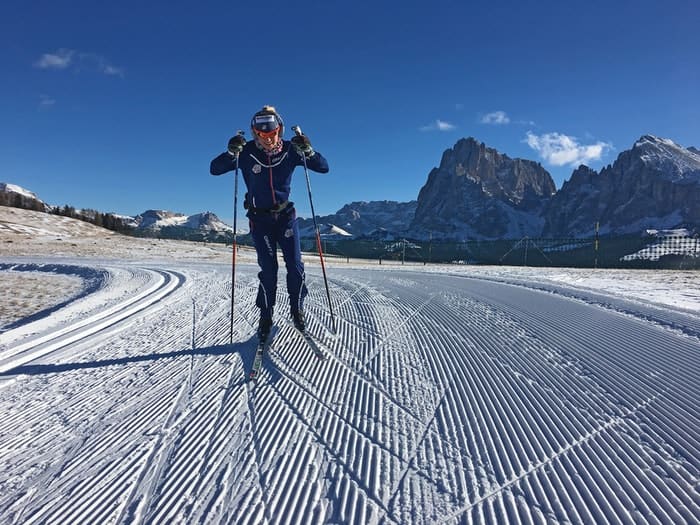
She aced it. In one 10K pursuit race in Canada late 2010, she started 40 seconds back—a huge handicap—behind two established U.S. national ski team members, Holly Brooks and Sadie Bjornsen, but powered past them to win the race.
She secured a place on the U.S. national ski team. Yet she had committed to ski for Northern Michigan. “Don’t come,” the college’s coach, Sten Fjeldheim, told her. “You can do this.”
At 19, she was easily the youngest member on the national ski team, intimidated to be teammates with the likes of Kikkan Randall, whom she had once asked to autograph a poster. In December 2012, Diggins and Randall teamed up in Quebec City for the freestyle relay and won, the United States’ first gold medal in a World Cup event.
Two months later, they won the team sprint at the World Championships, another American first. The following season, a 4 x 5K freestyle relay team Diggins anchored finished third at the World Cup in Norway.
And then she was in Sochi, February 7, 2014, on parade in the Opening Ceremonies of the XXII Winter Olympic Games alongside Shawn White and Lindsey Vonn. “I did it,” Diggins thought. “I made it. This is the highest stage I’ll ever be on.”
The Opening Ceremonies were on the eve of her first event, the skiathlon (which takes the combined times of a 7.5K classic race and a 7.5K freestyle race), and an hour-long drive from her bed in the Olympic Village. The prudent thing would have been to skip the ceremonies to ensure a solid night’s sleep. But Diggins would not be denied that experience, and the next day she finished eighth, better than expected and the best result for a U.S. woman.
With her parents there along with a couple dozen other family and friends and many more watching back home during middle-of-the-night viewing parties at the Chilkoot Café in downtown Stillwater, Diggins finished ninth in the 4 x 5K relay, 13th in the freestyle sprint, and 40th in the 30K mass start. She returned to Minnesota with a desire to improve her technique. She had only four years until the next Olympics.
Nordic skiing originates in Norway, and is predictably dominated by the Norwegians and their Scandinavian neighbors. An American ranked number six in the world is beyond surprising. It’s akin to someone from Iceland quarterbacking the Cowboys in the Super Bowl.
Diggins has shaken up the silent sport not only with her success but with her personality. Her enthusiasm is infectious. Even the most stoic of her opponents now smile when the camera pans the start.
She’s had an even more profound impact on her teammates. Want to see? Google “Uptown Funk U.S. Ski Team.”
Up pops a professional-quality music video filmed over three weeks and four countries and released the day before the 2015 World Championships opened in Falun, Sweden. It immediately went viral, reaching nearly a million views within two days. The video is a playful romp, the men and women of the U.S. Ski Team dancing and lip-syncing to the Mark Ronson/Bruno Mars hit. An inveterate dancer herself, Diggins initiated the idea, choreographed the moves, and patiently tutored her teammates, coaches, and support staff.
“It’s a big stress relief,” she says. “Training for the Olympics, there’s a lot of pressure and people are feeling the nerves. My role is team cheerleader. I try to keep everyone positive and motivated. I’m just naturally bouncy and happy.”
Seems that’s how she’s always been. Her high school coach, Kris Hansen, tells the story of the section championship when Diggins was a sophomore, and it was a tight contest to see which team would advance to state. Diggins won the race, of course, but wasn’t done when she crossed the finish line. “Before her skis had stopped, she kicked them off and ran onto the course to cheer on her teammates,” Hansen said. “What I love about Jessie is that she could have said, ‘I won. Look at me.’ But she didn’t even celebrate. She just turned around to support her teammates.”
Her teammates and coaches know Diggins as “the Glitter Fairy.” She decorates her cheeks with glitter and face paint before races, a practice that dates back to Stillwater High, when she used to get so nervous before races she could hardly function. The glitter helped her relax, to not worry about the outcome and simply give it her best effort.
It has caught on. Mornings of relay races, nervous tension crackles through the hotel rooms occupied by the U.S. Ski Team. That’s soothed by a knock on Diggins’ door. Time to get glittered up. She paints an American flag on one cheek, “USA” on the other, and then a teammate does the same for Diggins.
“It’s this promise to myself that I am going to go out and race as hard as I can because I love what I do,” she says. “I want to honor the little girl who just wants to go super-speed.”
They call it the Coulee, the hill on St. Croix Trail in Afton where local skiers train on roller skis. The two-kilometer climb is a tough workout for the best of the local skiers. When Diggins, who grew up nearby, is in town, she’ll do the Coulee, then turn left at the top and keep going another kilometer up another hill. Local skiers call it “the Jessie Extension.” Her training exploits are legend.
One summer day on Stratton Mountain in Vermont, coach Cork tells her to bound up the mountain at race pace. He marks the spot she reaches in three minutes with a small pile of rocks. Then she goes down to her initial starting point and after a three-minute rest bounds up to the pile of rocks. She’ll keep repeating that until she can no longer reach the finish line within three minutes. Cork figured she would be able to complete maybe seven intervals.
After five, Diggins was on her hands and knees, heart rate through the roof, quads and calves on fire. She picked herself up, jogged down the hill, and hit it again. Six. Again, the effort brought her to her knees, gasping. Once again, she dragged herself down the hill and did it again. Seven. She crumbled, dry-heaving.
“You done?” Cork asked.
She looked up at him. “One more.”
Eight. Nine. Ten.
Any one of those times up the mountain, she could have backed off a little bit, eased up on the pain, and been done. Nobody would’ve known. But she didn’t. Cork realized she wouldn’t quit until her body totally betrayed her. He made her stop. “It’s easy for elite athletes to say, ‘I’ll never quit,’ but really very few are able to put themselves in that hole—she is able to do it,” he says. “She probably could’ve done five more—and would have been willing to.”
To fully appreciate Jessie Diggins, you must know this about cross country skiing. It’s about suffering. It demands the entire body get involved and that the mind be able to sustain the cries of “Uncle” from muscle groups in multiple locations. The secret to Diggins’ success is her will to withstand this suffering.
When she was winning the 5K freestyle race in 2015, her first individual World Cup victory, the television commentator noted, “She is not a pretty skier, but if you want to look for heart on a ski course, look no further than Jessie Diggins. She is so tough.”
Two years later, recounting her 2017 performance in the World Cup, where she finished the season ranked sixth, another commentator remarked, “She probably has that ability more than any other skier on the world tour, the ability to dig deep.”
Diggins calls it “the pain cave,” which she defines as “that very special place where everything hurts.”
She’s not afraid of the dark. “Instead of saying, ‘Oh no, oh no, I want to give up,’ I welcome it, know I need to move through it instead of letting it paralyze me,” she says.
She discovered that asset in eighth grade during her first relay race. Not wanting to let down her teammates, she skied harder than she knew she could. She thought she was going to blow up. “I was in so much pain at the finish line, it was unbelievable,” she says. “But I realized I can push myself really hard.”
Back at the World Championships in Lahti, Finland, this past February, as the Norwegian crosses the finish line, a Russian behind her, taking gold and silver in the team classic sprint, two more skiers come into the picture, barreling down the straightaway. “There’s the battle behind them,” the television announcer says. “It’s Jessie Diggins of the United States on the left, Stina Nilsson of Sweden on the right.”
Nilsson is one of the best sprinters in the world. Diggins is crunching away, matching the Swede pole plant for pole plant, neck and neck. “To the line they come….”
Diggins throws her right ski forward, mouth open, completely taxed, and raises one arm overhead. “Jessie Diggins gets the bronze for the United States!”
The pain on Diggins’ face gives way to a smile. She collapses into the arms of her teammate, Sadie Bjornsen.
“Just incredible,” the announcer says. “She showed so much fight today.”
Diggins had found herself deep in the pain cave. That’s where she won the sprint and her first medal in a classic event. “In the final 100 meters, I kept thinking, ‘I can, I can, I can because Sadie needs me,” she says. “Nilsson is known for having an incredible finish in the final 100 meters, but I had a mental edge because I wanted this for Sadie and me so much that I was able to dig and go harder than ever for her. The best performances of my life have been team events.”
Remember the commentator who said, “She is not a pretty skier”? That’s been the rap against Diggins, a sizable flaw in a sport where technique can trump fitness. Her classic technique in particular has been her Achilles heel.
But she has worked hard to overcome that weakness. She has skied behind Annie Hart to study her technique and worked with coach Jason Cork. Three years ago, Diggins had never qualified in a classic sprint. She has since not missed qualifying (finishing in the top 30). The bronze in 2017 crowned that effort. “I have been identified as a skater, but I’ve been working really hard at classic. That race was the first time I really believed I could do it as a classic skier.”
Everyone asks, “Do you know no American has won a medal in an Olympic cross-country ski race since Bill Koch won silver in 1976?”
Yeah. She knows. She had a poster of Koch on her bedroom wall.
She knows that she is America’s best chance to win a medal in Nordic at this year’s Winter Games. She will be one of the favorites in the 15K skiathlon, the 10K freestyle sprint, the freestyle team sprint, and the 4 x 5 relay.
No American woman has ever medaled in Nordic. That’s a lot of pressure. But not a problem. “She doesn’t choke,” Clay Diggins says. “She rises to the occasion.”
Four years have passed since Sochi, where her best finish was eighth in the skiathlon, and things will be different in PyeongChang. For starters, the hosts from those Games will not be competing under the Russian flag, or with the assistance of back-room scientists dumping their dirty urine samples. Grigory Rodchenkov, the former head of the Russian antidoping lab, has said that 14 of Russia’s 20 Nordic skiers (male and female) in 2014 were benefitting from performance-enhancing substances. Eleven have been named and eight have been banned for life from the Olympics with their Sochi results erased.
In the four years since Sochi, Diggins has matured. At 26, she is closer to the age when Nordic skiers tend to peak (late 20s, early 30s). She’s got four more years of training in her. Four years of honing her technique. Four years of wisdom, knowing how to read her body, when to push herself, when to rest. Four more years of confidence built upon success.
That last attribute may not have come as naturally as expected. She’s worked with a sports psychologist to get to the point where she can have absolute faith in herself. It hasn’t always been there, she admits. The psychologist asked Diggins, Why do you think you can’t win? Someone’s got to, why not you? You’ve put in all the training. “I learned to say, ‘Yeah, I can win this,” Diggins says. “I’m not shooting for the top 25; I want to win.”
So when you see her in the starting gate at the Olympics, smiling and waving to the camera, dancing to loosen up, you might be able to hear her, if you lean in real close, saying to herself, “I’m about to make history—and I love it!”
Postscript: Diggins turned in an amazing performance in the 2018 Olympics in PyeongChang. Among the world’s best skiers, she placed ffith in the 10K, fifth in the 15K skiathlon, seventh in the 30K, sixth in the sprint, and fifth in the 4 x 5K relay. She and Kikkan Randall won the team sprint, becoming the first American Nordic skiers to earn Olympic gold. Diggins secured the victory with one of the most incredible finishes ever in any sporting event, outdueling Sweden’s Stina Nilsson and Norway’s Maiken Caspersen Falla in the final kilometer and nipping Nilsson by 19 hundredths of a second in the sprint. The U.S. Olympic team honored Diggins by selecting her to carry the American flag in the closing ceremony.
© John Rosengren
